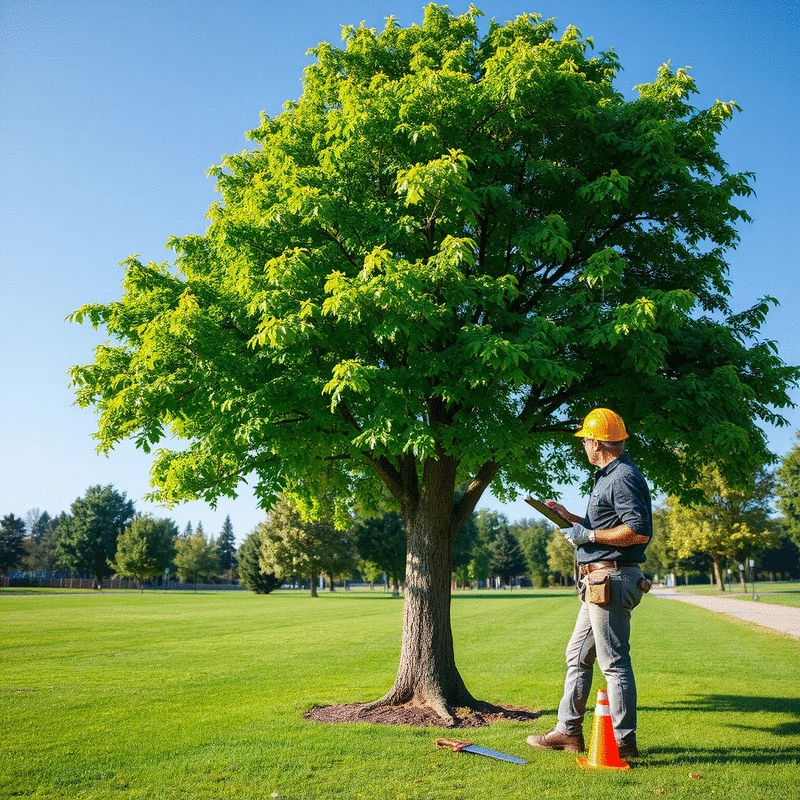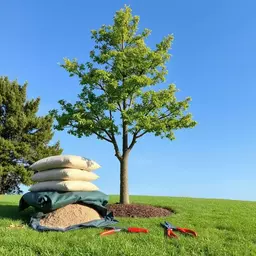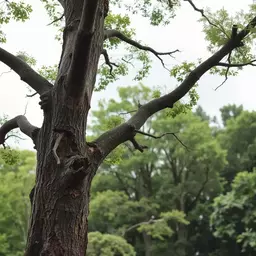Tree Safety Risk Prevention Tips

As our communities grow and change, the importance of tree safety becomes increasingly vital. Trees not only enhance our environment but also pose risks if not properly managed. Understanding the balance between appreciating nature and ensuring safety is fundamental. Here’s what you will learn about effective tree safety management and risk prevention.
What You Will Learn
- Proactive tree safety management ensures that the aesthetic and environmental benefits of trees are preserved while minimizing risks.
- Common hazards include weak roots, overgrown branches, pests, and environmental factors, all of which require regular inspections to identify early.
- Utilizing technology such as drones and GIS mapping can significantly enhance monitoring and assessment of tree health.
- Establishing a comprehensive tree maintenance plan with regular inspections and emergency response strategies is crucial for long-term tree health.
- Sustainable practices like organic fertilization, mulching, and native species planting contribute to both tree health and environmental stewardship.
- Documentation of tree care is essential for liability protection and informed decision-making regarding tree management.
- Community education and involvement in tree care initiatives foster a culture of safety and responsibility within neighborhoods.
Risk Assessment Strategies for Tree Safety
Understanding the key steps and tools for effective tree risk assessments ensures the safety of your trees and property. Below are critical strategies and tools that can help mitigate risks associated with tree hazards. For more detailed insights, consider exploring long-term tree risk management tips.
Key Risk Assessment Steps
- Visual inspection of all trees.
- Look for signs of decay, damage, or disease.
- Assess the surrounding environment for potential hazards.
- Document findings to track changes over time.
Utilizing Technology in Assessments
- Drones for aerial imagery and inspections.
- GIS mapping for area risk tracking.
- AI for data analysis and trend identification.
Assessment Tools
- Visual assessment tools for on-site inspections.
- Tree risk assessment software for data collection.
- Inspection checklists for thorough evaluations.
Impact of Regular Assessments
Regular assessments help in early detection of risks, ensuring proactive measures are taken to prevent major incidents, ultimately protecting properties and lives.
Understanding Long-Term Tree Safety and Risk Prevention
The Importance of Tree Safety Management
Trees are vital for our environment and communities. They provide shade, improve air quality, and enhance the beauty of our neighborhoods. At Safe Canopy Care, we believe that proactive tree safety management is essential to ensure that these natural assets continue to thrive while protecting our homes and families from potential hazards.
Effective tree safety management not only focuses on the health of the trees but also on the potential risks they pose. By implementing safety measures, we can create a harmonious balance between appreciating the beauty of trees and minimizing the risks associated with them. It's about being responsible stewards of our environment!
- Enhancing overall community aesthetic
- Improving air quality
- Providing shade and habitat for wildlife
- Reducing energy costs through natural cooling
Identifying the Risks Associated with Trees
Like any living organism, trees can develop issues that may lead to hazards. Understanding the various risks associated with tree health, structural integrity, and environmental factors is crucial. Common hazards include:
- Weak or decayed roots, which can undermine stability.
- Overgrown branches, which may pose a risk of falling.
- Pests and diseases that can weaken trees and make them prone to failure.
- Environmental factors, such as storms and drought, that can exacerbate existing problems.
Identifying these risks early can save homeowners from costly damages and provide peace of mind. One of the best ways to do this is through regular inspections, which can help spot issues before they escalate. For more information on dealing with potential dangers, see our guide on hazardous tree removal best practices.
Hazard Tree Identification
Identifying hazardous trees is a key part of tree safety management. Techniques for recognizing these threats can include:
- Regular visual inspections for signs of decay or damage.
- Assessing tree structure for irregularities.
- Checking for root issues, such as heaving or exposed roots.
- Monitoring leaf health for signs of pests or disease.
Recognizing the implications of hazardous trees is essential. These trees can pose risks not only to your property but also to your loved ones. At Safe Canopy Care, we emphasize education and awareness to ensure you are equipped to identify potential threats.
Effective Risk Assessment Strategies for Tree Safety
Conducting Comprehensive Tree Risk Assessments
To ensure the safety of your trees, conducting thorough risk assessments is vital. Here are the steps you can take:
- Begin with a visual inspection of all trees.
- Look for signs of decay, damage, or disease.
- Assess the surrounding environment for potential hazards.
- Document findings to track changes over time.
Regular risk assessments help you stay ahead of potential issues. They enable you to take action promptly, preventing a small problem from becoming a major headache!
Utilizing Technology for Enhanced Risk Monitoring
Technology is rapidly changing the way we manage tree safety. Utilizing tools like drones, AI, and GIS mapping can greatly enhance your tree monitoring efforts. These technologies allow for:
- High-resolution images to spot early signs of trouble.
- Data analysis for trends in tree health.
- Mapping out areas of risk in large properties.
By embracing these innovative solutions, we can provide a higher level of care and protection for our trees. It’s a game-changer for proactive risk management!
Tree Risk Assessment Tools
There are various tools available to aid in conducting effective tree risk assessments. Some of these include:
- Visual assessment tools for on-site inspections.
- Tree risk assessment software for data collection and analysis.
- Inspection checklists to ensure thorough evaluations.
With the right tools at your disposal, you can ensure that your tree assessments are comprehensive and effective. Remember, at Safe Canopy Care, we are here to support you in making informed decisions about tree safety!
Pro Tip
Did you know? Regular tree inspections can identify issues as small as hairline cracks or minor pest infestations before they escalate into significant hazards. Scheduling these inspections bi-annually can save you from costly damages and ensure the safety of your property and loved ones.
Highlighting Sustainability and Environmental Benefits
Healthy trees play a crucial role in maintaining our environment and enhancing the beauty of our communities. They help improve air quality, provide shade, and create habitats for wildlife. As a tree safety expert, I've seen firsthand how well-maintained trees contribute to an overall sense of well-being and community health, making it essential for us to prioritize their care.
Moreover, trees absorb carbon dioxide, which is vital in combating climate change. When we implement proactive measures to maintain tree health, we’re not just protecting our properties but also contributing to a larger environmental impact. It's a win-win situation for everyone!
The Role of Healthy Trees in Ecosystem Stability
Well-maintained trees contribute significantly to ecosystem stability. They offer a variety of benefits, including:
- Improved Air Quality: Trees filter pollutants and produce oxygen, making the air we breathe cleaner.
- Enhanced Aesthetics: Beautiful trees add charm and character to our neighborhoods.
- Wildlife Habitats: Trees provide shelter and food for various species, promoting biodiversity.
By investing in tree care, we nurture not only individual trees but the entire ecosystem. It's about creating a healthier environment for ourselves and generations to come.
Promoting Sustainable Tree Care Practices
There are several eco-friendly practices we can adopt for managing our trees. Here’s a list of sustainable practices that benefit both the trees and the environment:
- Organic Fertilization: Use natural fertilizers to promote healthy growth without harmful chemicals.
- Mulching: Apply mulch to retain moisture and suppress weeds, while enriching the soil.
- Water Conservation: Implement drip irrigation systems to minimize water waste.
- Native Species Planting: Choose native tree species that thrive in our local climate and support local wildlife.
At Safe Canopy Care, we advocate for these practices because they not only improve tree health but also align with our mission of environmental stewardship.
Urban Forestry and Its Importance
Urban forestry is a critical aspect of tree care, especially in densely populated areas. It involves managing and maintaining trees in urban settings for numerous benefits:
- Increased Green Space: Urban forests enhance the aesthetic appeal of cities and provide recreational areas.
- Climate Regulation: Trees cool urban areas, reducing the heat island effect.
- Stormwater Management: Trees absorb rainwater, reducing runoff and improving water quality.
By investing in urban forestry, we create safer and more enjoyable environments for our communities, reinforcing the importance of tree safety in urban planning. For tips on how to prepare your trees for harsh conditions, check out preparing trees for storm season.
Documenting and Developing Tree Management Policies
Keeping detailed records of tree care is essential for effective management. Documentation not only helps track tree health and maintenance but also protects property owners from potential liabilities. Having accurate records can be a lifesaver when it comes to compliance with local regulations.
Moreover, as I often tell my clients, organized records provide insights into the long-term health of your trees, enabling proactive measures before issues arise.
Importance of Keeping Detailed Records of Tree Care
The benefits of maintaining detailed records include:
- Liability Protection: Documentation can help defend against claims related to tree damage or injuries.
- Management Efficiency: Helps track maintenance schedules and identify recurring issues.
- Improved Decision-Making: Data-driven decisions lead to better tree care strategies.
At Safe Canopy Care, we emphasize the importance of documentation to ensure long-term success in tree management.
Legal and Liability Considerations for Tree Owners
Tree owners must understand their responsibilities regarding tree safety. Here are some key points to consider:
- Insurance Implications: Be aware of how your homeowner’s insurance covers tree-related incidents.
- Compliance: Familiarize yourself with local regulations governing tree care and maintenance.
- Property Owner Responsibilities: Ensure trees are regularly inspected and maintained to avoid hazards.
Being proactive in understanding these factors can save you time and money in the long run while keeping your property safe.
Tree Maintenance Plans and Best Practices
Developing a comprehensive maintenance plan is vital for long-term tree health. Here’s a simple outline of what such a plan might include:
- Regular Inspections: Schedule annual or bi-annual tree inspections to identify potential hazards.
- Pruning Schedule: Implement a pruning schedule to maintain tree shape and health.
- Emergency Response Plans: Prepare for potential emergencies by having a tree care professional on call.
At Safe Canopy Care, I always advocate for tailored maintenance plans that reflect the specific needs of your trees, ensuring their longevity and safety.
Future-Proofing Tree Safety Strategies Against Climate Change
As climate change continues to affect weather patterns, we must adapt our tree care techniques accordingly. This means understanding the unique challenges that each region faces and adjusting our strategies to protect our trees and property.
By staying informed and flexible, we can ensure the health and safety of our trees amid changing conditions. For immediate assistance with urgent tree issues, learn more about essential tree emergency tips.
Adapting Tree Care Techniques for Changing Climates
Consider these adaptive strategies to protect your trees:
- Selecting Resilient Species: Choose tree species that can withstand extreme weather conditions.
- Adjusting Watering Practices: Modify watering schedules based on changing precipitation patterns.
- Monitoring for Pests: Be vigilant about pest populations that may increase with climate changes.
By incorporating these strategies, we can build resilience in our communities and safeguard our treasured trees.
Budgeting for Long-Term Tree Maintenance
Planning for tree maintenance expenses is crucial. Here are some tips for budgeting:
- Set Aside a Maintenance Fund: Create a fund specifically for tree care expenses.
- Prioritize Major Projects: Identify and budget for any major pruning or removal projects.
- Utilize Professional Services: Consider investing in professional services for comprehensive assessments.
Investing in tree maintenance today can save you from costly repairs in the future. At Safe Canopy Care, we help clients plan for these expenses to ensure their properties stay safe and beautiful.
Encouraging Ongoing Engagement and Education
Education is key in promoting tree safety awareness. By providing resources and support to tree care enthusiasts, we can foster a community that values tree health and safety.
Engagement also allows us to share knowledge and experiences, leading to improved practices and community resilience. To find reliable professionals, you might want to look into using a tree service directory.
Providing Resources and Support for Tree Care Enthusiasts
Here are some valuable resources to get started:
- Online Courses: Consider enrolling in tree safety and management courses like our Safe Canopy Care Tree Safety Masterclass.
- Local Workshops: Attend local workshops and seminars that focus on tree care practices.
- Tree Care Blogs: Follow tree care blogs and websites for the latest updates and tips.
By utilizing these resources, you can gain the knowledge needed to effectively manage your trees.
Call to Action for Community Involvement in Tree Safety
I encourage everyone to participate in local tree care initiatives. Whether it's volunteering for community tree planting events or advocating for better tree management policies, every small action counts!
Together, we can strengthen our communities and create safer environments for ourselves and future generations.
Community Education and Outreach Programs
Community education plays a vital role in promoting tree safety. By engaging in outreach programs, we can:
- Raise Awareness: Share information about tree hazards and safety practices with neighbors.
- Encourage Participation: Motivate community members to get involved in tree care initiatives.
- Foster Stewardship: Cultivate a sense of responsibility for the trees in our neighborhoods.
At Safe Canopy Care, we're committed to community education as a cornerstone of our mission. Let’s work together to foster a culture of safety and environmental stewardship!
Frequently Asked Questions About Tree Safety
What are the most common tree hazards?
Common tree hazards include weak or decayed roots, overgrown branches, pest infestations, and diseases. Environmental factors like storms and drought can also exacerbate these problems.
How often should trees be inspected for safety?
Regular inspections, ideally annual or bi-annual, are recommended to identify potential hazards early on and prevent them from escalating into major issues.
Can technology help in tree risk assessment?
Yes, technologies like drones for aerial imagery, GIS mapping for tracking risk areas, and AI for data analysis can significantly enhance the accuracy and efficiency of tree risk assessments.
What are sustainable tree care practices?
Sustainable practices include organic fertilization, mulching to retain moisture and enrich soil, water conservation methods like drip irrigation, and planting native tree species that thrive in the local climate.
Why is documentation important for tree owners?
Detailed records of tree care are crucial for liability protection, helping to defend against claims related to tree damage. They also aid in management efficiency and informed decision-making regarding long-term tree health.
Recap of Key Points
Here is a quick recap of the important points discussed in the article:
- Tree Safety Management: Proactive management is essential for preserving tree health and minimizing risks to properties and individuals.
- Identifying Risks: Regular inspections help detect weak roots, overgrown branches, pest infestations, and environmental hazards early on.
- Technology Utilization: Embrace modern tools such as drones and GIS mapping for enhanced monitoring and data analysis.
- Comprehensive Risk Assessments: Conduct thorough assessments regularly to document tree health and address issues promptly.
- Sustainability Practices: Adopt eco-friendly methods, such as organic fertilization and native species planting, to enhance tree care.
- Community Engagement: Encourage local participation in tree safety initiatives and provide educational resources to promote awareness.
- Legal Responsibilities: Understand your obligations as a tree owner, including insurance implications and compliance with local regulations.
- Long-Term Planning: Develop a maintenance plan that includes regular inspections, pruning schedules, and budgeting for potential expenses.
Popular Posts
 Storms can be unpredictable, but your response doesn’t have to be. By understanding storm prepared
Storms can be unpredictable, but your response doesn’t have to be. By understanding storm prepared
 As storms can strike without warning, ensuring the safety of your trees is not just a precaution—i
As storms can strike without warning, ensuring the safety of your trees is not just a precaution—i
 Have you ever considered how a single tree could be a ticking time bomb for your property? Understan
Have you ever considered how a single tree could be a ticking time bomb for your property? Understan
 Have you ever considered how something as seemingly benign as a tree can quickly become a danger? Ea
Have you ever considered how something as seemingly benign as a tree can quickly become a danger? Ea
